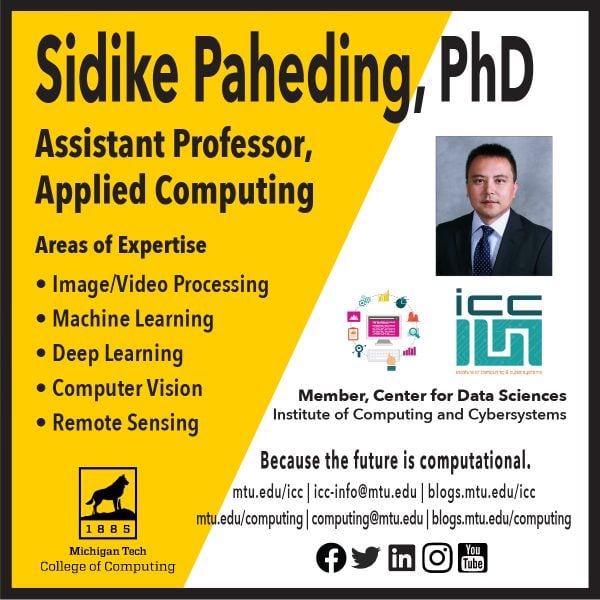
An article by Dr. Sidike Paheding, Applied Computing, has been accepted for publication in the Elsevier journal, Remote Sensing of Environment, a top journal with an impact factor of 9.085. The journal is ranked #1 in the field of remote sensing, according to Google Scholar.
The paper, “Estimation of root zone soil moisture from ground and remotely sensed soil information with multisensor data fusion and automated machine learning,” will be published in Volume 260, July 2021 of the journal. Read and download the article here.
Highlights
- A machine learning approach to estimation of root zone soil moisture is introduced.
- Remotely sensed optical reflectance is fused with physical soil properties.
- The machine learning models well capture in situ measured root zone soil moisture.
- Model estimates improve when measured near-surface soil moisture is used as input.
Paheding’s co-authors are:
- Ebrahim Babaeian, Assistant Research Professor, Environmental Science, University of Arizona, Tucson
- Vijay K. Devabhaktuni, Professor of Electrical Engineering, Department Chair, Purdue University Northwest, Hammond, IN
- Nahian Siddique, Graduate Student, Purdue University Northwest
- Markus Tuller, Professor, Environmental Science, University of Arizona
Abstract
Root zone soil moisture (RZSM) estimation and monitoring based on high spatial resolution remote sensing information such as obtained with an Unmanned Aerial System (UAS) is of significant interest for field-scale precision irrigation management, particularly in water-limited regions of the world. To date, there is no accurate and widely accepted model that relies on UAS optical surface reflectance observations for RZSM estimation at high spatial resolution. This study is aimed at the development of a new approach for RZSM estimation based on the fusion of high spatial resolution optical reflectance UAS observations with physical and hydraulic soil information integrated into Automated Machine Learning (AutoML). The H2O AutoML platform includes a number of advanced machine learning algorithms that efficiently perform feature selection and automatically identify complex relationships between inputs and outputs. Twelve models combining UAS optical observations with various soil properties were developed in a hierarchical manner and fed into AutoML to estimate surface, near-surface, and root zone soil moisture. The addition of independently measured surface and near-surface soil moisture information to the hierarchical models to improve RZSM estimation was investigated. The accuracy of soil moisture estimates was evaluated based on a comparison with Time Domain Reflectometry (TDR) sensors that were deployed to monitor surface, near-surface and root zone soil moisture dynamics. The obtained results indicate that the consideration of physical and hydraulic soil properties together with UAS optical observations improves soil moisture estimation, especially for the root zone with a RMSE of about 0.04 cm3 cm−3. Accurate RZSM estimates were obtained when measured surface and near-surface soil moisture data was added to the hierarchical models, yielding RMSE values below 0.02 cm3 cm−3 and R and NSE values above 0.90. The generated high spatial resolution RZSM maps clearly capture the spatial variability of soil moisture at the field scale. The presented framework can aid farm scale precision irrigation management via improving the crop water use efficiency and reducing the risk of groundwater contamination.
Remote Sensing of Environment (RSE) serves the Earth observation community with the publication of results on the theory, science, applications, and technology of remote sensing studies. Thoroughly interdisciplinary, RSE publishes on terrestrial, oceanic and atmospheric sensing. The emphasis of the journal is on biophysical and quantitative approaches to remote sensing at local to global scales.